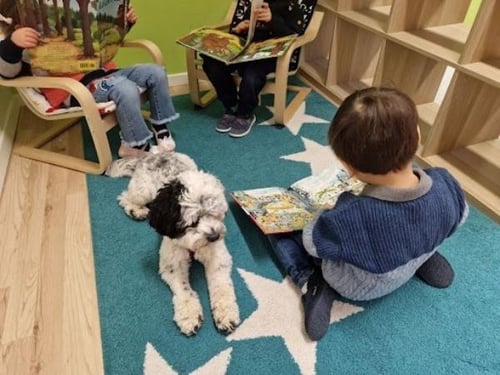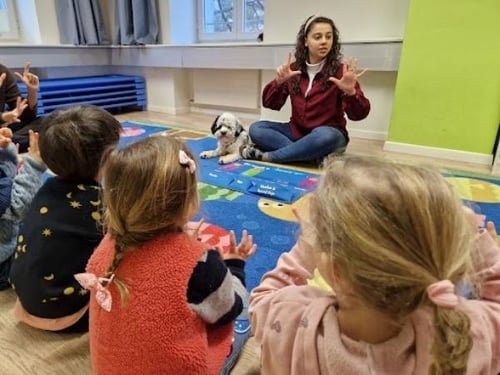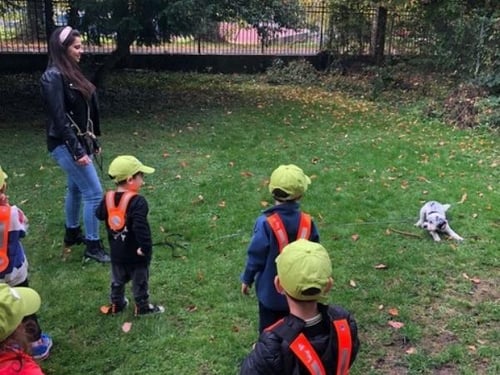Meet our new team member «Nala», School Dog at Pre-School
Have you ever heard of a school having a dog to help children concentrate better, to strengthen self-esteem, improve social competencies, learn empathy and encourage motivation to participate and learn? Our Pre-School teacher, Michaela, presented her concept for a «school dog» in 2021. Two years later, Nala, our Australian labradoodle school dog, has become the favourite companion in our Pre-School class.
During this interview, Michaela gives us some insight into this adventure and the experience they have had in Pre-School.

What started the idea of having a school dog?
It is a combination of many things. I grew up in South Africa, having dogs and loving animals in general. In fact, I always wanted to work with animals. But when I moved to Switzerland at the age of 16, I decided to follow my other passion - children. I started to study to be a «FaBe», Fachperson Betreuung mit Fachrichtung Kinderbetreuung. At the same time, I looked into dog assisted therapy, hippotherapy (therapy with horses) and gained some experience in that field. Combined with my experience as a teacher, I felt that children could benefit from additional support as some of them were facing challenges in their development or social competencies. I was sure that having a dog would be a great resource and boost all the other work we are already doing at Tandem IMS.
What is «animal assisted therapy / teaching»?
For many years, animals have been supporting different methods of therapy. When animals are used to support in the psychological and medicinal fields, this is called «animal assisted therapy». Examples of such therapy are hippotherapy, swimming with dolphins and visits in homes with animals such as dogs, cats, bunnies etc.
«Animal assisted teaching» is the integration of an animal in a pedagogical field. The animal plays the role of a supporting and accompanying medium in the education and development of children.
Tell me about Nala, our school dog!
Nala is an Australian labradoodle. They are known to be family and child-friendly dogs. Their hypoallergenic fur is ideal as the Australian labradoodles are known for being non-shedding. Nala was born in April 2022 and currently weighs 6 kg. She likes meeting new people and dogs, is courageous and curious. Last summer she learnt to swim, to be in big crowds of people, to travel via public transport and completed her puppy course.
What training will Nala complete?
As mentioned, Nala completed the «Puppy Training» last summer which was then followed by «Young Dog Training». When Nala is about 1 year old, she is old enough to do the mandatory «School Dog Training». Once she has completed the «School Dog Training», she can be involved in the school lessons with more variety and specific goals. What I am doing now is getting her used to the school environment. Right now she is learning about the children and their behaviours such as their little screeches when they get excited or their cries when they are sad. Examples of interactions the children have with her now are giving her a treat, a gentle stroke, having her join circle time or playing fetch outside. This way, Nala learns to interact and associate all these positive experiences with the children.
What is the aim of «School Dog Training»?
School Dog Training will give me more insight into how to implement Nala into our school life. The training takes between 4 to 10 months. Once this training has been completed, Nala will be able to assist a lesson with the children, our Pre-Schoolers, who are between three and four years old, more diversely.
Let me give you one example: You have cones. Underneath the cones are pictures. I would give Nala the signal to lift one of the cones, and the children would then have to call out the name of that picture and call out words that rhyme with that picture. Doing activities together with a trained school dog keeps the children far more focused and motivated, and at the same time, it will boost the environment for learning.
Introducing trained dogs to school (from pre-schools to high schools) is a relatively new concept, but the interest is growing as studies show the positive effects of contact with animals, on the development of children from a young age. There are of course also concerns schools have. These generally refer to biting, allergy and fears. Therefore, biting prevention lessons are a must and part of this is teaching children to understand a dog’s body language, respecting the dog’s boundaries and recognising their own boundaries as well. It is important to ensure that a child is ready to approach a dog and if it is not, to build up the confidence very slowly. Overall, a very strong bond between me, the dog owner, and the dog is crucial for a successful school dog. This also means that every interaction between Nala and the children only happens when I am present.
Having a school dog has benefits. What are they?
A school dog is useful to help children build relationships, promote communication and experience empathy. Even more fearful children can gain more positive experiences through the calm behaviour of a school dog.
I can observe how Nala’s presence alone brings calm into the classroom. At the same time, the children feel excited and motivated. A relaxed atmosphere is an important foundation for learning. Dog assisted teaching helps support better concentration and endurance and also teaches children how to recognise and accept the needs of others. From an early age, they learn about responsibilities, become more empathetic and in doing so improve social competencies.
«Dogs love us unconditionally, they accept us with no judgement and therefore support us in many different ways. They give us a sense of trust, comfort and warmth which boosts motivation and capabilities.»
Having Nala in our classroom also helps the children learn about dogs in general. When we go to the park, for example, we often encounter dogs that are running around without leashes. We teach the children what to do when a dog they do not know approaches them, and how to greet a new dog for the first time.
How did you prepare for this project and how was the introduction of Nala to the Pre-Schoolers?
After I got the go-ahead from the School Director, I talked with the breeder and confirmed my interest in a puppy. It then took another year, which allowed us to inform parents and prepare for it. For example, we had to create a space for Nala in the classroom, where it is quiet and where she is not disturbed. At the parent information evening, I took Nala with me so that parents could meet her and ask questions.
The introduction of Nala to the children only happened once my teaching partner and I were sure that the children had settled in and were used to our daily routine. During the settling-in phase of the children, we started talking about Nala and showed pictures and videos of her. The children also participated in various dog lessons and activities. In fact, we first practised with a stuffed dog. Once it was time to introduce Nala, she only came to class for one morning when only four children were present. We then built up Nala’s presence very slowly for both the children and Nala.

What is your routine, and what has your experience been so far?
We have a so called Nala calendar so the children know when Nala is at school, as well as a sign on the door so that anyone who enters the classroom is aware that Nala is present. We also introduced rule cards to learn what is proper and improper behaviour: Do we run or walk? Are we loud or quiet? It is interesting to see that the volume in the classroom goes down when Nala is there. We talk about how they feel when Nala does something and also how Nala may feel when they do something. Those interactions boost their success in learning empathy and applying it to their interactions with their classmates. The children learnt for example that it is exciting for Nala when they are loud or when they are running, this is seen as playful behaviour by a dog. This is one of the goals: every learning experience with Nala can be applied to other areas. When learning the dog body language, we of course also learn about our body language. Patience and constant repetition are crucial - for both the children and Nala.
Have there been tricky moments when introducing Nala?
In our Pre-School class, we had one girl who was scared of dogs. I had to keep a close eye on the girl, watching how she responded to Nala. We taught the children how to interact with dogs, how to behave around dogs and that there is no reason to be afraid of Nala. I always give the children the option if they want to approach Nala or not. As a result, this girl in my class, who was scared at first, is no longer scared. It is wonderful to see how she now interacts with Nala.
Another tricky situation was that we did not know how a child, who has an animal allergy, would react to Nala. So at first, the child did not have any physical contact with her. After two weeks, we introduced the child to stroking and giving a treat. The parents and I then assessed the situation and we can now assume that the child has no allergic reactions to Nala which is great. In fact, being in the classroom together with Nala, without physical contact, should, in general, not create an allergic reaction.
What is your main goal?
My main goal is that we have a 100% reliable dog who can roam free in the classroom, who supports the lessons and who can feel things from the children that we are not able to feel immediately. Nala may then be able to independently provide comfort by, for example, just sitting next to them to calm them. Of course, I will always be there when Nala is in the classroom and the children will never interact with Nala alone.
Also, as the children at that age are learning a lot emotionally and socially, with Nala the
atmosphere is positive which is an important foundation for learning. And by having Nala in our class, other important areas also feel the benefit. Areas such as concentration, motivation, participation, empathy, confidence, responsibility (set and accept boundaries) and communication (practise a new language - a dog is a great listener). Enhancing these aspects helps the children to get ready for their next step - kindergarten.
You see, the current Pre-School group is growing up with Nala. The children know that not only they but also Nala, are learning. The group will help Nala succeed in becoming a school dog. When the children move on to Kindergarten they are, of course, always welcome to come and visit Nala.
Thank you very much for the interview. We are looking forward to catching up with you next school year.



WRITE A COMMENT
Your email address will not be published.